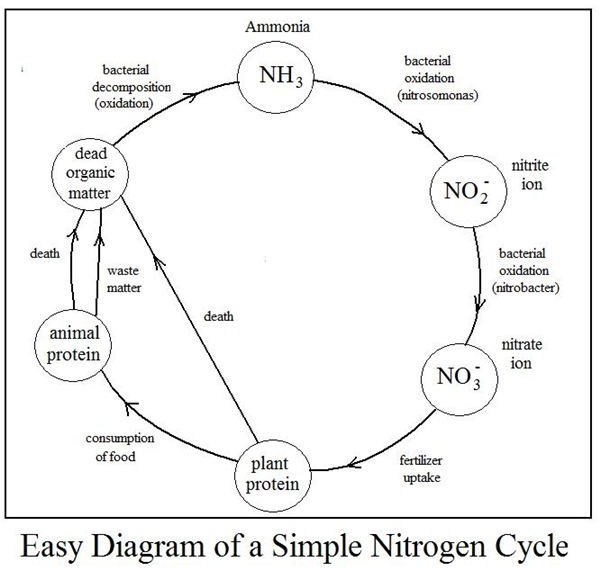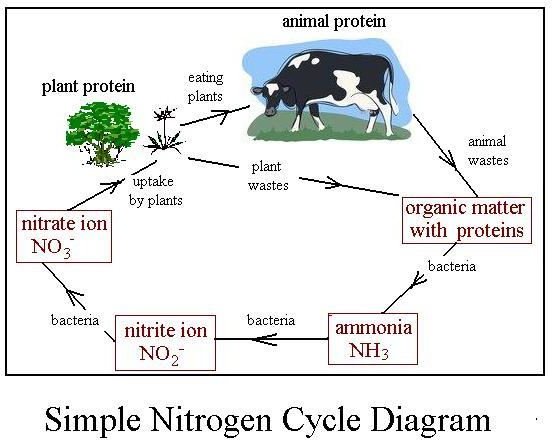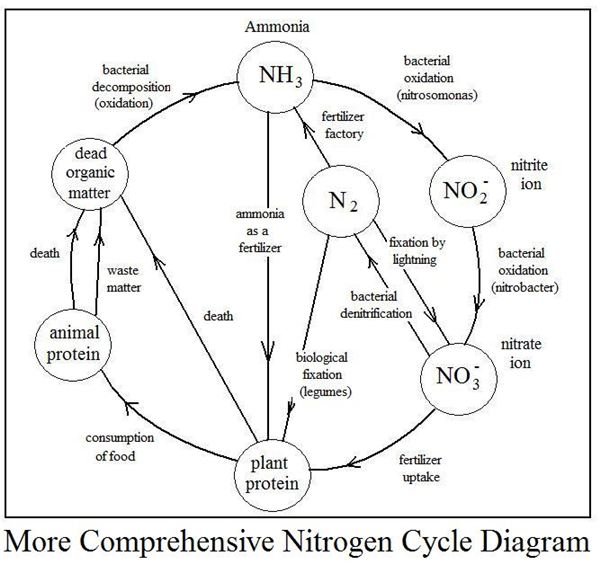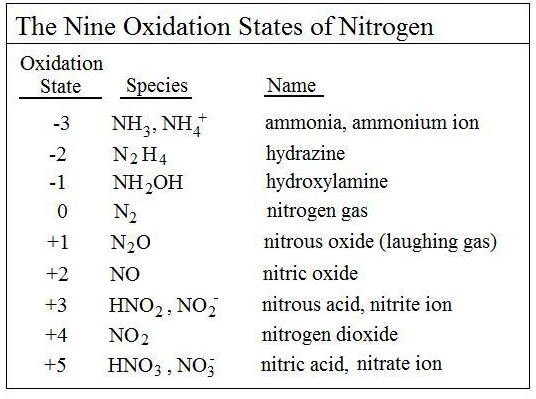Easy Diagram of Nitrogen Cycle Shows Conversions in the Simple Nitrogen Cycle
The Importance of Nitrogen and the Nitrogen Cycle
Nitrogen is an important component of all proteins, and thus is vital to all plant and animal life. Just as plants are vital because of their ability to convert carbon dioxide and water into plant organic matter (food for animals) in the carbon cycle, they are also vital because of their ability to convert inorganic nitrogen in the soil into organic nitrogen (plant proteins). The cycle of processes that is called the simple nitrogen cycle in this article consists of dead, decaying organic nitrogen breaking down to release ammonia, which is oxidized by microbes to nitrite and then to nitrate, which can be taken up by plants to produce organic nitrogen again.
An additional route for creation of organic nitrogen from inorganic nitrogen is fixation of atmospheric nitrogen by the class of plants called legumes. This process and the conversions between nitrogen gas and the other forms of nitrogen will be added in to create the more comprehensive nitrogen cycle diagram also presented in this article.
The Many Different Forms of Nitrogen
Nitrogen may well have the distinction of being the element that can exist in the greatest number of different oxidation states. There are nitrogen species with nine different oxidation states, having all the possible oxidation states (valences) from -3 to +5, as shown in the table at the left. Three of these nine species of nitrogen (ammonia, nitrate, and nitrite) are included in an easy diagram of the nitrogen cycle illustrating a simple nitrogen cycle in the next section. A fourth species, nitrogen gas, is included in the more comprehensive nitrogen cycle diagram in the following section.
In addition to the importance of the simple nitrogen cycle in making continuous creation of plant protein possible, some of the conversions are important in wastewater treatment, when ammonia and/or nitrate are present in the wastewater. Some of the other species (nitrous oxide, nitric oxide, and nitrogen dioxide) have another environmental engineering application, because they are important reactants in the type of air pollution known as photochemical smog.
An Easy diagram of the Nitrogen Cycle Illustrating the ‘Simple Nitrogen Cycle’
The easy diagram of the nitrogen cycle shown in two versions here is for the simple nitrogen cycle that applies to plants other than legumes. It involves

ammonia, nitrite, nitrate, and protein. This simple nitrogen cycle is almost a simple circle. There is a ‘shortcuts’ for death of plants to become dead organic matter.

We can start consideration of this simple nitrogen cycle with any of the nitrogen species, as for example, with nitrate in the soil serving as fertilizer for plant growth. The inorganic nitrate is taken up by the plants and used to synthesize proteins. The plants either serve as food for animals, with the plant protein thus becoming animal protein, or else the plants eventually die and become dead organic matter. Animals give off waste containing protein and ammonia and at some time they die and become dead organic matter. Dead organic matter will typically be oxidized by aerobic bacteria converting the carbon, hydrogen, and oxygen to carbon dioxide and water, and releasing ammonia from the proteins. Ammonia is oxidized to nitrite ion by nitrosomonas bacteria and nitrite is oxidized to nitrate by nitrobacter bacteria. This takes us back to the beginning with the nitrate available to be utilized by growing plants.
A More Comprehensive Nitrogen Cycle Diagram

When conversions between atmospheric nitrogen and the nitrogen species in the simple nitrogen cycle diagram are included, the result is the more comprehensive nitrogen cycle diagram at left. Atmospheric nitrogen (N2) cannot be utilized by plants directly, but N2 can be converted to nitrate through electrical discharge fixation due to lightning. N2 is also used as a reactant to produce ammonium ion in fertilizer production. Biological fixation of atmospheric nitrogen by legumes converts N2 to ammonia, which is taken up by the plant and used to make plant protein. Nitrate can be converted to atmospheric nitrogen by biological denitrification. Note that there are intermediate products in some of the reaction described here. Only the end products were included in this discussion.
